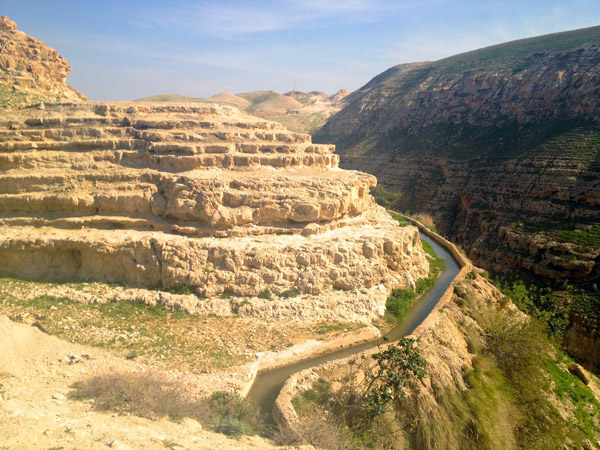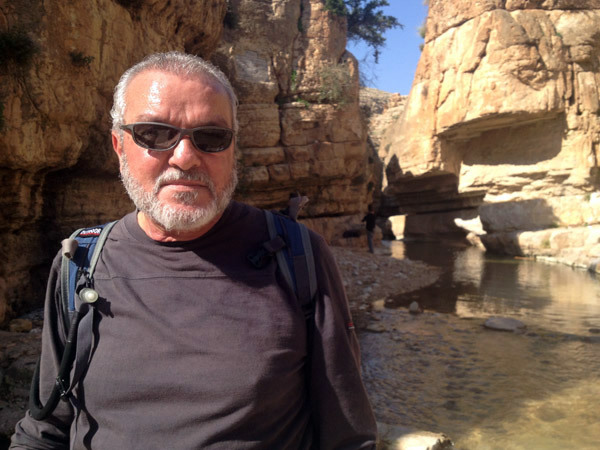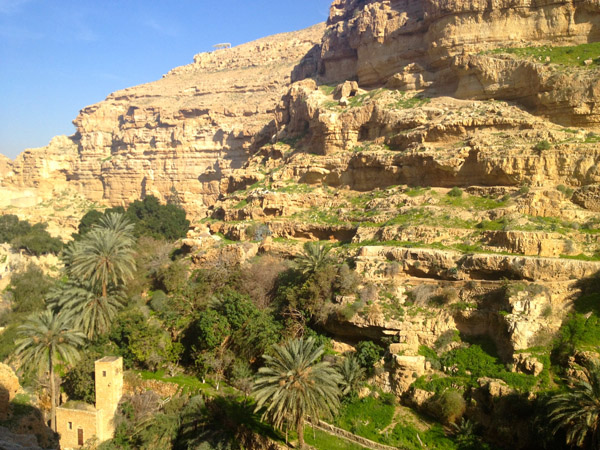For many Palestinians, recreational hiking is an odd thing to do. The political geography makes it complicated and Israelis and Palestinians fight over the right to mark trails. And yet, a hike through Wadi Qelt is still worth it.
By Angela Gruber

Two young Palestinian guys pass by, not looking all too interested in our hiking group, though their facial expressions betray a distinguishable touch of bewilderment. Our routes cross on a small, dusty trail in the Wadi Qelt in the Jordan Valley. As quickly as they appeared, the two men disappear in the other direction.
Hikers are a rather extraordinary appearance in the West Bank. “Walking around in nature for fun is not something a lot of Palestinians do,” our guide, Suhail Hijazi, explains. Hikers asking local Palestinians for directions might be surprised when the response arrives as a politely suggest to take a cab.
And while hiking may seem like an apolitical activity, in the West Bank politics always find a way in. The small hilly territory is, after all, an intricate patchwork of visible and invisible boundaries interspersed with Israeli army checkpoints, fenced off settlements and closed military zones. There are few marked paths and the political geography makes things even more complicated.
Expanding the net of hiking trails in the West Bank is a contested endeavor: when Palestinians recently marked a trail that briefly overlapped with an existing Israeli trail, it didn’t last very long. The Palestinian white-green-white tags were smashed out of the stone one night; the Israeli signs were left untouched by the — unknown — vandals.
One of Hijazi’s favorite hiking tours leads through Wadi Qelt, a dried-up canyon east of Jerusalem. The 15-kilometer hike snakes alongside an old Roman aqueduct.

Steep, craggy slopes tower above us as we make our way past small oases, camels resting in the sand and simple Bedouin houses. The windows in the unplastered concrete walls had no glass in it, giving the houses a slightly unfinished look. Peeking through one, I could see a dim, almost empty room with a matress in one corner and a small, wooden table in the middle of the room. Like most places in the Middle East, hiking through Wadi Qelt weaves together breathtaking landscapes, a storied history and biblical narratives. Jesus is said to have traveled through the valley within a valley, and it is supposed to be where the narration of the Good Samaritan took place.
“Yallah,“ Hijazi shouts, signaling our departure after a few precious minutes resting in the shade of a thorny tree, the slopes to our left covered in a green fluff from the recent winter’s rain. The sun will burn it off soon, leaving behind nothing but reddish-brown stone and soil.
Our hiking trail doesn’t lead us through the deepest part of the V-shaped wadi, but rather edges along some 50 meters up. It can become scorching hot in the Jordan Valley, which contains a strange mix of arid desert, fertile wadis that channel rainwater, traditional grazing lands and an occasional Israeli settlement. At this time of the year, however, the temperatures are still pleasant enough; I’m grateful. Although the altitude difference we have to cover is not that big, it does get hot as soon as you start climbing.
“I just love to walk around and explore my homeland on foot,“ says Hijazi, 63 from Ramallah. He is a tall man who wears a pair of dark sunglasses against the blazing sun. “I started guiding tours in 2012, but I’ve been hiking on my own for decades. It’s been so long, I can’t even remember when I started,“ he says. Rarely do other Palestinians join him for his tours. His best customers are expats and other foreigners who are in the region for longer periods of time.
Tourists rarely make it. “Most of the tourists go to the Israeli tourist center and get maps for trails on the other side. They don’t come to the West Bank,” Hijazi says. “It’s a shame. You can do so many beautiful hikes here. The nature is wilder, untouched.“

Hijazi believes that hiking is not only a good way to show foreigners the West Bank, he says. Guided tours like his also help the local economy. Along with their boots and hats, hikers also bring money.
Even as a foreign hiker, the tensions between Israelis and Palestinians can be felt. Sometimes Palestinians mistake well-intentioned hikers for settlers. A few months earlier, during the olive harvest, I found myself in such a situation in the hills surrounding Ramallah. Seeing non-Palestinians making their way through the slopes of olive groves, we became immediately aware of the concerned eyes focusing on us. The tension only broke when Hijazi called out a few Arabic words, explaining what the group was doing. I guess they still found our hiking endeavors odd, but were at least reassured we weren’t there to scout out their lands or destroy their trees.
The situation in the wadi is calm. It’s a popular area with the few hikers that do come here. The water it holds is fed by three springs. It was in order to transport the water to Jericho below that the Romans built the aqueduct.
“The Romans have created something magnificent,” Hijazi says. “The structure of the aqueduct with its bridges and tunnels through the rock is unbelievable and unique.”
Even ancient irrigation becomes political in the West Bank, however. In order to clear its channels and fix its cracks Palestinians must get permission from the Israeli army, he explains.
Angela Gruber, 26, is a German journalist, blogger and intern at +972 Magazine. She’s a scholar for the “trialog of cultures” scholarship of the German Quandt foundation and reports from Israel. Follow her on Twitter: @netzkolumnistin. A version of this text appeared on the German news site ZEIT ONLINE.

